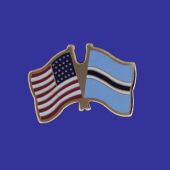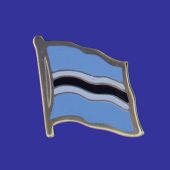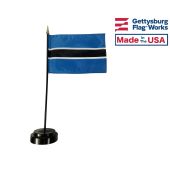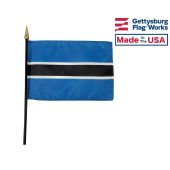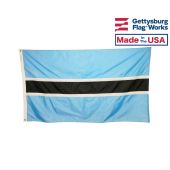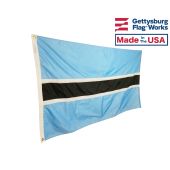Flag of Botswana
Flag of Botswana
The flag of Botswana stands out from the flags of other African nations because it does not include the colors of the Pan-African movement or any symbols associated with the country's ruling political parties. That is a deliberate choice, since the Botswana flag was designed to contrast with the flags of other African nations.
The national flag of Botswana was adopted on September 30, 1966. The flag is light blue with a black horizontal band across the centre, with white fimbriation. The stripes are in a ratio of 9:1:4:1:9. The blue colour stands for water, specifically rain, and comes from the motto on the Botswana coat-of-arms, which states Pula, the Setswana word for "Let there be rain". The white and black bands stand for racial harmony, and also refer to the zebras that support the nation's coat of arms.
- Capital of Botswana: Gaborone
- Area of Botswana: 585,370 sq. km.
- Languages used in Botswana: Setswana, Kalanga, Sekgalagadi, English (official)
- Religions in Botswana: Christian, Badimo
Colors and Symbolism of the Botswana Flag
The flag of Botswana is a light blue field that is divided through the center by a black line with a white border around it. The light blue field is a symbolic representation of the rain that is so important in Botswana due to the nation's generally arid climate. The black and white lines are reminiscent of the zebra populations that are common in Botswana, but they also serve to represent the peaceful coexistence of the citizens who are descended from European colonists with the citizens who are descended from native Africans. The simple and understated design was intended to offer a strong contrast to the flag of South Africa, which was ruled by an apartheid government that did not encourage that kind of peaceful coexistence.
History of the Flag of Botswana
Botswana was an oddity among British colonies because it did not have a colonial flag to represent it within the British Empire. The British flag was often used as an informal Botswana flag, but there was no legal authorization for that use. The colony, which was known as Bechuanaland while it was part of the British Empire, simply did not have a flag to call its own until it received its independence and began to call itself Botswana.
Thus Botswana gained its first national flag when it gained its independence from the British Empire in 1966. The flag was designed before the nation became formally independent so that it could be displayed on the very first day of the new nation's existence. The flag's designers intended it to be a symbol of hope and a better future, so they carefully designed that flag to remind people that they could avoid the problems that were gripping other nations in Africa. The flag was popular with the people of Botswana, and it has been used without any changes ever since it was first adopted.
